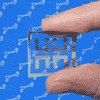Electronic memory chips may soon gain the ability to bend and twist as a result of work by engineers at the National Institute of Standards and Technology (NIST). As reported in the July 2009 issue of IEEE Electron Device Letters,* the engineers have found a way to build a flexible memory component out of inexpensive, readily available materials.

Though not yet ready for the marketplace, the new device is promising not only because of its potential applications in medicine and other fields, but because it also appears to possess the characteristics of a memristor, a fundamentally new component for electronic circuits that industry scientists developed in 2008.** NIST has filed for a patent on the flexible memory device (application #12/341.059).
Electronic components that can flex without breaking are coveted by portable device manufacturers for many reasons—and not just because people have a tendency to drop their mp3 players. Small medical sensors that can be worn on the skin to monitor vital signs such as heart rate or blood sugar could benefit patients with conditions that require constant maintenance, for example. Though some flexible components exist, creating flexible memory has been a technical barrier, according to NIST researchers.
Hunting for a solution, the researchers took polymer sheets—the sort that transparencies for overhead projectors are made from—and experimented with depositing a thin film of titanium dioxide, an ingredient in sunscreen, on their surfaces. Instead of using expensive equipment to deposit the titanium dioxide as is traditionally done, the material was deposited by a sol gel process, which consists of spinning the material in liquid form and letting it set, like making gelatin. By adding electrical contacts, the team created a flexible memory switch that operates on less than 10 volts, maintains its memory when power is lost, and still functions after being flexed more than 4,000 times.
What’s more, the switch’s performance bears a strong resemblance to that of a memristor, a component theorized in 1971 as a fourth fundamental circuit element (along with the capacitor, resistor and inductor). A memristor is, in essence, a resistor that changes its resistance depending on the amount of current that is sent through it—and retains this resistance even after the power is turned off. Industrial scientists announced they had created a memristor last year, and the NIST component demonstrates similar electrical behavior, but is also flexible. Now that the team has successfully fabricated a memristor, NIST can begin to explore the metrology that may be necessary to study the device’s unique electrical behavior.
“We wanted to make a flexible memory component that would advance the development and metrology of flexible electronics, while being economical enough for widespread use,” says NIST researcher Nadine Gergel-Hackett. “Because the active component of our device can be fabricated from a liquid, there is the potential that in the future we can print the entire memory device as simply and inexpensively as we now print a slide on an overhead transparency.”
* N. Gergel-Hackett, B. Hamadani, B. Dunlap, J. Suehle, C. Richter, C. Hacker, D. Gundlach. A flexible solution-processed memristor. IEEE Electron Device Letters, Vol. 30, No. 7. Posted online the week of June 8, 2009.
** D. B. Strukov, G. S. Snider, D. R. Stewart, and S. R. Williams. The missing memristor found. Nature, Vol. 453, May 1, 2008.
NIST researchers have used inexpensive, readily available materials to create an electronic memory chip that can be bent or twisted—some 4,000 times in tests—and still keep functioning.